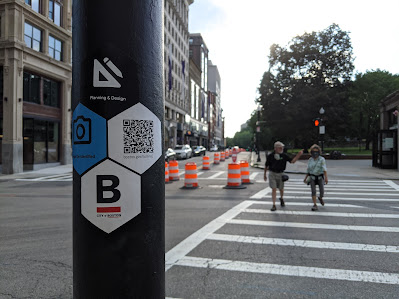Digital Trust for Places and Routines
What if you could learn about all the technology around you just by scanning a QR code?
We’ve probably all had the experience of walking down a street, spotting a camera on a light pole overhead, and wondering what exactly it’s doing there. What kind of camera is that? Who’s watching the footage from the camera? What are they using the data for?
We think if we make this information more available and ask for feedback, we can open up community-led conversations about what technology people do and don’t want on the streets of Boston. That’s why we’ve partnered with technology transparency organization Helpful Places to try out DTPR (Digital Trust for Places and Routines) signage in Boston.
DTPR
Background
NEW TECH, NEW TALK
As more effective data-based urban planning becomes possible through new technology, Boston is considering deploying interconnected sensors in our public spaces. We believe people should be able to quickly understand how data collection technologies work, and the purposes they serve. So we're putting in place infrastructure to let residents know about data collection in the public realm and solicit their feedback.
HelpFUL PLACEs
Helpful Places is a social impact enterprise with a creative approach to public technology transparency. Led by Jackie Lu, Helpful Places stewards DTPR, an open-source communication standard designed to increase transparency, legibility, and accountability for technologies in public spaces.
Boston was the first ever city to experiment with DTPR, and we’re excited about both what we’ve learned here and what cities around the world are now exploring in partnership with Helpful Places.
Co-Creating A DATA LAnguage
A common language is the first step towards a culture of transparent and contestable data management. The DTPR taxonomy was developed to easily inform residents about:
- The purpose of data collection
- The technology used
- Who is accountable for the project outcomes
- What happens to the collected data
Learn more about the icons we use and what they mean.
How it works
How it works
See the Sensor
- Notice the icons
- Scan the QR code

Learn about the data collected
- Understand the purpose of the data collection
- Get informed about how your data is used

Tell us what you think
- Share your thoughts on this method of data collection
- Help us improve this experience
Experiments around Boston
In our first experiments with DTPR signage, we printed skate-style stickers that we attached to poles at sites around Boston where we deployed technologies like traffic sensors. People were able to learn about how the technologies worked. We learned that the stickers look cool, but don’t always hold up as well through rough Boston winters.
In our second phase of experiments, we tested DTPR signage around Boston’s first ever deployment of air quality sensors for a major reconstruction project. Along Cummins Highway in Mattapan, we set up more durable and redesigned signs on poles near each air quality monitor. With our Civic Design Cohort, we learned from conversations with residents that the new signs’ formats and conversational language work, but people want information about data collection presented in narrative context about their lives and neighborhoods, and want more open access to the data collected by the City. We’re working on this, as well as on deploying signs in areas where people can engage more easily and for longer.
Building a transparency network
We were glad to participate in the first ever DTPR City Cohort, with fellow municipalities Washington DC, Innisfil Ontario, and Angers Loire Metropolitan Region. Together we shared learnings and experimented with new formats for signage deployment.
It’s exciting to see Helpful Places’ work and this approach to technology transparency catching on in cities across the world. The experiments have also gotten recognition from the World Economic Forum and the American Planning Association, among many others. We're looking forward to what comes next.
Your thoughts
What do you think of this approach to public realm technology? Would you like to see DTPR signage on a technology in your neighborhood? Reach out to us at newurbanmechanics@boston.gov and to Helpful Places at dtpr@helpfulplaces.com.







